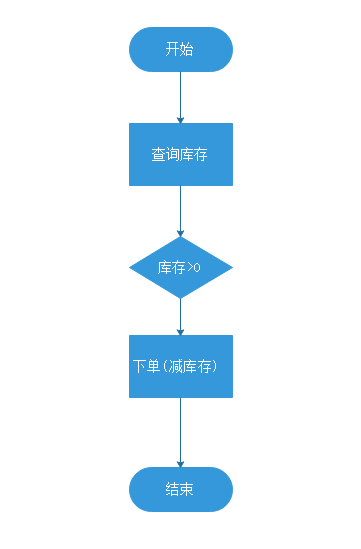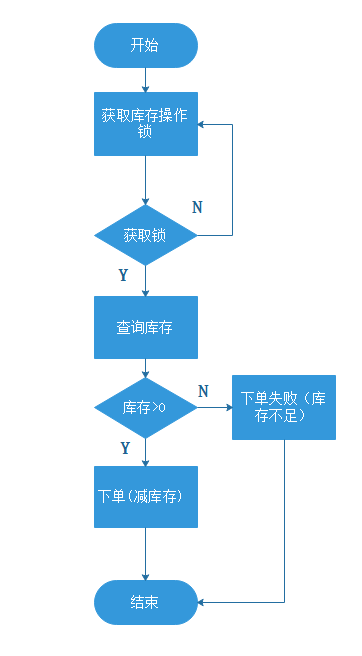分布式应用中,需要如何解决资源同步的问题?
这篇文章讲解的很不错了。Redis 分布式锁的正确实现方式( Java 版 )。另外在Github上也有一个demo做的很不错。
什么时候需要用到分布式锁呢?比如:减库存。
假设某个商品的库存是N,有N+1个订单过来,那么势必只能有N个有效订单。那么如何保证库存不出现负数的情况呢?(多个减库存操作保证库存的同步)

图一:减库存流程图

图二:分布式锁减库操作
利用Redis就可以给库存加一个分布式锁。需要注意的是不要造成死锁,即保证持有锁有一定的时限制。
获取锁的过程可以是:在redis服务器set一个key-value,lock。如果此lock已经存在,则说明当前锁被其他线程持有。否则set此lock的值。lock需要有设置存活时间(保证不死锁)。另外需要注意手动释放锁的时候,需要保证是当前持有锁的线程去释放。
import org.springframework.data.redis.core.RedisTemplate;
import org.springframework.data.redis.core.script.DefaultRedisScript;
import org.springframework.web.bind.annotation.GetMapping;
import org.springframework.web.bind.annotation.RequestMapping;
import org.springframework.web.bind.annotation.RestController;
import javax.annotation.Resource;
import java.util.Collections;
@RestController
@RequestMapping
public class RedisTemplateController {
@Resource(name = "myRedisTemplate")
private RedisTemplate<String, String> redisTemplate;
@GetMapping(value = "set")
public String set(String key, String value) {
redisTemplate.opsForValue().set(key, value);
return "success";
}
@GetMapping(value = "get")
public String get(String key) {
return redisTemplate.opsForValue().get(key);
}
/**
* 加锁
* @param key
* @param value
* @return
*/
@GetMapping(value = "redisTemplateLock")
public Object lock(String key, String value) {
String script = "local key = KEYS[1]; local value = ARGV[1]; if redis.call('set', key, value, 'NX' ,'PX', 5000) then return 1 else return 0 end";
DefaultRedisScript<Long> redisScript = new DefaultRedisScript<>(script, Long.class);
Object execute = redisTemplate.execute(redisScript, Collections.singletonList(key), Collections.singletonList(value));
System.out.println(execute);
return execute;
}
/**
* 阻塞锁
*/
@GetMapping(value = "blockLock")
public String blockLock(String key, String value) throws InterruptedException {
// 被阻塞的时间超过5秒就停止获取锁
int blockTime = 5000;
// 默认的间隔时间
int defaultTime = 1000;
for(;;) {
if(blockTime >= 0) {
String script = "local key = KEYS[1]; local value = ARGV[1]; if redis.call('set', key, value, 'NX' ,'PX', 5000) then return 1 else return 0 end";
DefaultRedisScript<Long> redisScript = new DefaultRedisScript<>(script, Long.class);
Long result = redisTemplate.execute(redisScript, Collections.singletonList(key), value);
System.out.println("try lock ... ,result: "+result);
if(result != null && result == 1) {
// 得到了锁
return "lock success";
} else {
blockTime -= defaultTime;
Thread.sleep(1000);
}
} else {
// 已经超时
return "lock timeout..., please retry later...";
}
}
}
/**
* 解锁
* @param key
* @param value
*/
@GetMapping("redisTemplateUnlock")
public String unlock(String key, String value) {
String script = "if redis.call('get', KEYS[1]) == ARGV[1] then return redis.call('del',KEYS[1]) else return 0 end";
DefaultRedisScript<Long> redisScript = new DefaultRedisScript<>(script, Long.class);
Long execute = redisTemplate.execute(redisScript, Collections.singletonList(key), value);
System.out.println("unlock result: "+execute);
if(execute != null && execute != 0) {
// 解锁成功
return "unlock success";
} else {
return "unlock failed";
}
}
}另外延伸出一个问题:如何保证一个60秒的延迟。Thread.sleep(60000)是否可以保证延迟60s。答案是不行。解决办法:
public void sleep(long millis) {
while (millis > 0) {
long begin = System.currentTimeMillis();
try {
Thread.sleep(millis);
} catch (Exception e) {
}
millis -= System.currentTimeMillis() - begin;
}
}
最后
以上就是鳗鱼白昼最近收集整理的关于分布式锁之redis分布式锁的全部内容,更多相关分布式锁之redis分布式锁内容请搜索靠谱客的其他文章。
本图文内容来源于网友提供,作为学习参考使用,或来自网络收集整理,版权属于原作者所有。








发表评论 取消回复